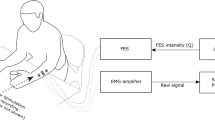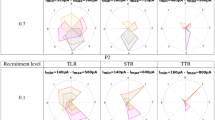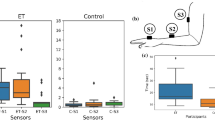Abstract
Study design
Proof of concept.
Objectives
Standard Functional Electrical Stimulation (FES) systems can enhance motor learning in people with tetraplegia and are widely delivered by self-adhesive electrodes. Their limitations are dexterity, specific knowledge to place the electrodes on muscles, need to fix electrodes when they lose the gel layer, and time. We designed a new FES system, using an existing protocol of drinking-like movements, to the upper limb of a person with tetraplegia C5 that fits in any anthropometry and can be easily produced. Furthermore, we tested the system to assess its effectiveness and users’ perception during FES rehabilitation.
Setting
São Carlos, SP, Brazil.
Methods
A shell was designed with parametric design and fast-fabrication methods, and a stimulation unit and a smartphone application were developed. Questionnaires assessed the perceptions of a patient and a physiotherapist, about the usability of the new system in relation to standard FES. Kinematic data of drinking-like movements were collected from the patient wearing both systems and compared with data from an aged-matched control subject.
Results
The results are a personalized shell and an intuitive FES system, overcoming the limitations of standard FES. The new system suggested better wrist-flexion control shown by the mean angles (−18.93°), then the other system (−59.35°), and compared with the control (−10.97°).
Conclusions
Fast-fabrication with parametric design offers a promising alternative for personalizing FES systems, with potential for home use. Further studies are required including randomized clinical trials.

Similar content being viewed by others
Log in or create a free account to read this content
Gain free access to this article, as well as selected content from this journal and more on nature.com
or
References
Bradbury EJ, Mcmahon SB. Spinal cord repair strategies: why do they work? Nature 2006;7:644–53.
Peckham PH, Keith MWFA. Restoration of functional control by electrical stimulation in the upper extremity of the quadriplegic patient. J Bone Jt Surg. 1988;70-A:144–8.
Fouad K, Tetzlaff W. Rehabilitative training and plasticity following spinal cord injury. Exp Neurol. 2012;235:91–9. https://doi.org/10.1016/j.expneurol.2011.02.009.
Varoto R, Cliquet Jr A. Experiencing functional electrical stimulation roots on education, and clinical developments in paraplegia and tetraplegia with technological innovation. Artif Organs. 2015;39:187–201.
Nagai MK, Marquez-Chin C, Popovic MR. Why Is Functional Electrical Stimulation Therapy Capable ofRestoring Motor Function Following Severe Injury to the Central Nervous System?. In: Tuszynski M (ed). Translational Neuroscience. Springer, Boston, MA. 2016. https://doi.org/10.1007/978-1-4899-7654-3_25.
Popovic MR, Kapadia N, Zivanovic V, Furlan JC, Craven BC, McGillivray C, et al. Functional electrical stimulation therapy of voluntary grasping versus only conventional rehabilitation for patients with subacute incomplete tetraplegia: A randomized clinical trial. Neurorehabil Neural Repair. 2011;25:433–42.
Alonso K, Azevedo E, Beinotti F, Maria R AC Jr. Electromyographic assessment of the tetraplegic upper limb during functional movement. J Neurol Sci. 2013;333:e564. https://doi.org/10.1016/j.jns.2013.07.1977.
Prochazka A, Gauthier M, Wieler M, Kenwell Z. The bionic glove: an electrical stimulator garment that provides controlled grasp and hand opening in quadriplegia. Arch Phys Med Rehabil. 1997;78:608–14.
Popovic D, Stojanovic A, Pjanovic A, Radosavljevic S, Popovic M, Vulovic D, et al. Clinical evaluation of the bionic glove. Arch Phys Med Rehabil. 1999;80:299–304.
Mangold S, Keller T, Curt A, Dietz V. Transcutaneous functional electrical stimulation for grasping in subjects with cervical spinal cord injury. Spinal Cord. 2005;43:1–13.
Fujii T, Seki K, Handa Y. Development of a new FES system with trained super-multichannel surface electrodes. 9th Annu Conf Int FES Soc Sept 2004. Bournemouth: UK Dev; 2004.p. 1–2.
Malesevic NM, Maneski LZP, Ilic V, Jorgovanovic N, Bijelic G, Keller T, et al. A multi-pad electrode based functional electrical stimulation system for restoration of grasp. J Neuroeng Rehabil. 2012;9:66.
Crema A, Malešević N, Furfaro I, Raschellà F, Pedrocchi A, Micera S, et al. A wearable multi-site system for NMES-based hand function restoration. IEEE Trans Neural Syst Rehabil Eng. 2018;26:428–40.
Konecny P, Jarkovsky J, Marques E, Novakova M, Palanova P, Mrkvicova V, et al. Home‐based training using neuromuscular electrical stimulation in patients on continuous ambulatory peritoneal dialysis: a pilot study. Artif Organs. 2018;1–10.
Moineau B, Marquez-chin C, Alizadeh-meghrazi M, Popovic MR. Garments for functional electrical stimulation: design and proofs of concept. J Rehabil Assist Technol Eng. 2019;6:1–15.
Pennati GV, Bergling H, Carment L, Borg J, Lindberg PG, Palmcrantz S. et al. Effects of 60?min electrostimulation with the EXOPULSE Mollii suit on objective signs of spasticity. Front Neurol. 2021;12:1–14.
Muccio P. Upper extremity biosleeve [Internet]. Vol. 1. United States; Patent: US 2016/0325090 A1, 2016. https://patents.justia.com/patent/20160325090.
Zabaleta H, Imatz E, Keller T. Device and system for functional electrical stimulation [Internet]. Vol. 1. Patent: EP 3 650 077 A1, 2020. p. 1–16. https://patents.google.com/patent/EP3650077A1/en?q=%22DEVICE+AND+SYSTEM+FOR+FUNCTIONAL+ELECTRICAL+STIMULATION%22.
Keller T, Popovic MR, Pappas IPI, Müller P. Transcutaneous functional electrical stimulator "Compex Motion.". Artif Organs. 2002;26:219–23.
Castro MCF, Cliquet A Jr. An artificial grasping evaluation system for the paralysed hand. Med Biol Eng Comput. 2000;38:275–80.
Popovic MR, Thrasher TA, Adams ME, Takes V, Zivanovic V, Tonack MI, et al. Functional electrical therapy: Retraining grasping in spinal cord injury. Spinal Cord. 2006;44:143–51.
Varoto R, Barbarini ES, Cliquet AJ. A hybrid system for upper limb movement restoration in quadriplegics. Artif Organs. 2008;32:725–729.
Thorsen R, Dalla Costa D, Chiaramonte S, Binda L, Beghi E, Redaelli T, et al. A noninvasive neuroprosthesis augments hand grasp force in individuals with cervical spinal cord injury: the functional and therapeutic effects. Sci World J. 2013;2013:1–7.
Patriciu A, Yoshida K, Struijk JJ, DeMonte TP, Joy MLG, Stødkilde-jørgensen H, et al. Current density imaging and electrically induced skin burns under surface electrodes. IEEE Trans Biomed Eng. 2005;52:2024–31.
Maffiuletti NA, Alessandro M. Atlas of the muscle motor points for the lower limb: implications for electrical stimulation procedures and electrode positioning. Eur J Appl Physiol. 2011;111:2461–71.
Snoek GJ, Ijzerman MJ, In’t Groen FACG, Stoffers TS, Zilvold G. Use of the NESS Handmaster to restore handfunction in tetraplegia: Clinical experiences in ten patients. Spinal Cord. 2000;38:244–9.
Mann S. Smart clothing: the wearable computer and WearCam. Pers Technol. 1997;1:21–7.
Janssen P. Dexen: a scalable and extensible platform for experimenting with population-based design exploration algorithms. Artif Intell Eng Des Anal Manuf. 2015;29:443–55.
Kolarevic B. Towards integrative design. Int J Arch Comput. 2009;07:335–44.
Redström J. RE: definitions of use. Des Stud. 2008;29:410–23.
Jaspers MWM. A comparison of usability methods for testing interactive health technologies: Methodological aspects and empirical evidence. Int J Med Inf. 2009;78:340–53.
Maguire M. Methods to support human-centred design. Int J Hum-Computer Stud. 2001;55:587–634.
Celani G. Changing the architectural production chain in Latin America with the introduction of new technologies. Mater Arquit. 2016;13:118–21.
Walker E, Cacho A, D Oliveira R, Ortolan RL, Varoto R, Cliquet A, et al. Upper limb assessment in tetraplegia: Clinical, functional and kinematic correlations. Int J Rehabil Res. 2011;34:65–72.
Reyes-Guzmán A de los, Gil-Agudo A, Peñasco-Martín B, Solís-Mozos M, Ama-Espinosa A del, Enrique Pérez-Rizo. et al. Kinematic analysis of the daily activity of drinking from a glass in a population with cervical spinal cord injury. J Neuroeng Rehabil. 2010;7:1–12.
Acknowledgements
The authors would like to acknowledge the Renato Archer Information Technology Center in particular Jorge Vicente Lopes da Silva, Pedro Yoshito Noritomi and Leonardo Mendes Ribeiro Machado for their assistance with 3D technologies, and Janiele Rossi and Geruza Perlato Bella for assistance in physiotherapy, and Dr. Mauro Masili, from University of São Paulo, for his valuable discussions and critical reading of the article.
Funding
FAPESP (2017/06147-4 and 2016/50253-0), Capes (88882.379203/2019-01), and CNPq.
Author information
Authors and Affiliations
Contributions
All authors conceived and designed the study that led to the submission of this paper, acquired data, and played an important role in the interpretation of the results. All authors wrote, reviewed the manuscript, and approved the final version, and also agreed to be responsible for all its aspects for ensuring issues on the accuracy or completeness of any part would be properly investigated and resolved.
Corresponding author
Ethics declarations
Competing interests
The authors declare no competing interests.
Additional information
Publisher’s note Springer Nature remains neutral with regard to jurisdictional claims in published maps and institutional affiliations.
Supplementary information
Rights and permissions
About this article
Cite this article
Ventura, A., Bataglia, J.M.P., Ginja, G. et al. Design and fast-fabrication of a system for functional electrical stimulation in upper limb of people with tetraplegia. Spinal Cord Ser Cases 8, 54 (2022). https://doi.org/10.1038/s41394-022-00519-5
Received:
Revised:
Accepted:
Published:
DOI: https://doi.org/10.1038/s41394-022-00519-5



